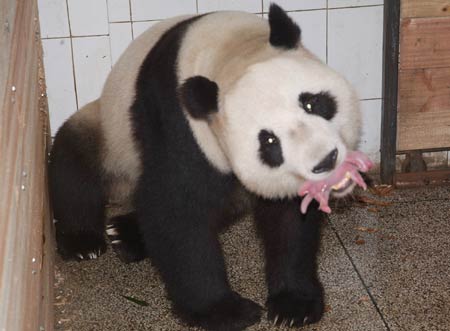The last group of giant pandas scheduled to leave the Wolong nature reserve in southwest China's Sichuan Province departed their quake-shattered base for foster homes on Tuesday.
On Monday night, 13 pandas arrived at the Bifengxia panda preservation base in Ya'an County, Sichuan, after a day's trip over two mountains.

Giant panda Guo Guo, an evacuee from the southwest China earthquake, gave birth to twins on Sunday, becoming the first panda to bear cubs since the disaster in Sichuan Province on May 12. (Xinhua Photo)
At the time of the earthquake, on May 12, there were 86 pandas at Wolong, also known as the China Conservation and Research Center for the Giant Panda.
Ya'an is the nearest place able to take in pandas. It received six of the bears 11 days after the 8.0-magnitude quake, which severely damaged the Wolong site. One of those pandas, Guo Guo, this month became the first of the species to give birth in captivity this year.
Ya'an prepared 16 panda pens of about 100 square meters each and a "kindergarten" of 300 square meters for the newcomers.
The Wolong reserve said it would keep seven panda cubs that were born last year. The reserve built a new panda house near the town seat of Wolong for the little ones.
The Wolong base, only 30 km from the quake's epicenter of Wenchuan County, suffered severe damage in the earthquake with the death of five staff and one panda. Fourteen of the 32 pens were destroyed.
In addition to Ya'an, Wolong pandas were moved to the panda research bases in east China's Fujian and southwest China's Yunnan and southern Guangdong provinces for foster care. The Beijing zoo also "borrowed" eight pandas from Wolong to add cheer to the Olympics this summer.
The Wolong base is still prone to secondary geological disasters such as landslides and mud-rock flows.
The State Forestry Administration is deliberating a rebuilding plan of the reserve, which was proposed to move the research center from the Hetaoping base to Huangcaoping, which is also in the reserve.
The new research center includes a 650-square meter lab, a panda hospital, a 1,500-square meter cub pen, a bamboo plantation and a site where pandas can be introduced to wildlife, according to the plan jointly drawn up by the administration of the Wolong reserve, Beijing University and the Chinese Academy of Sciences.
Zhang Hemin, head of the Wolong reserve, told Xinhua that the plan was the best by far among several options. The rebuilding would be completed by 2015, if the plan was approved, he said.
About 1,590 pandas live in the wild in China, mostly in Sichuan and the northwestern provinces of Shaanxi and Gansu. Another 180 are being bred in captivity.
(Xinhua News Agency July 23, 2008)